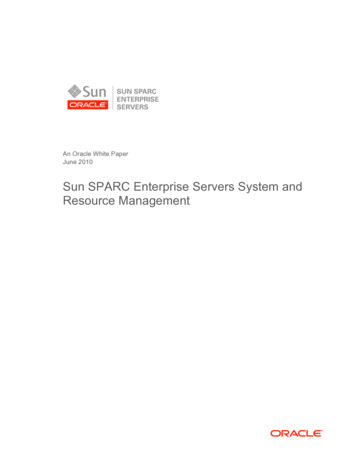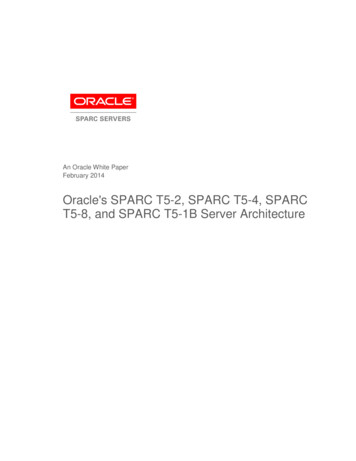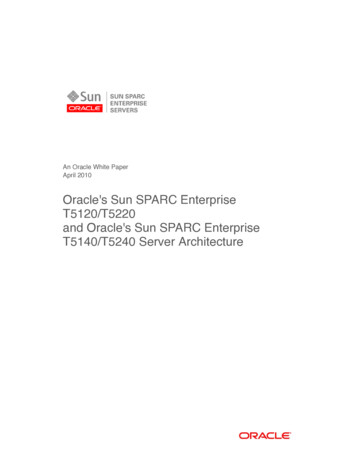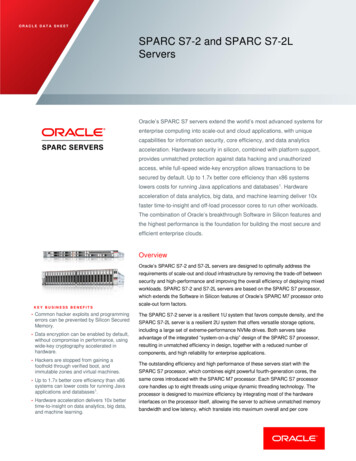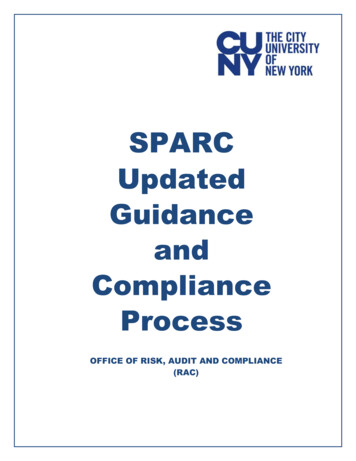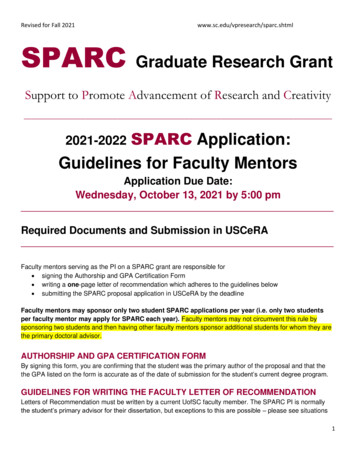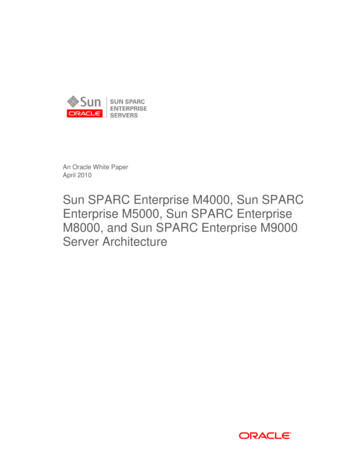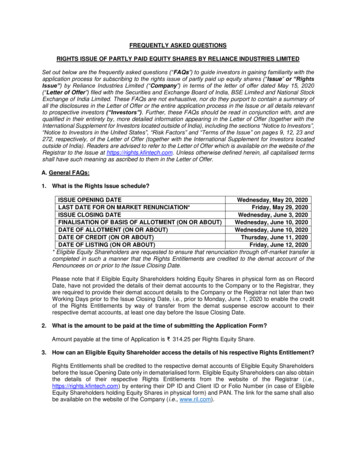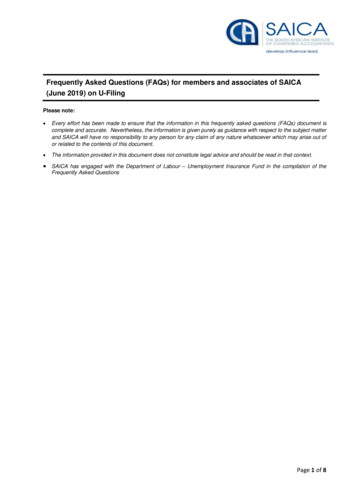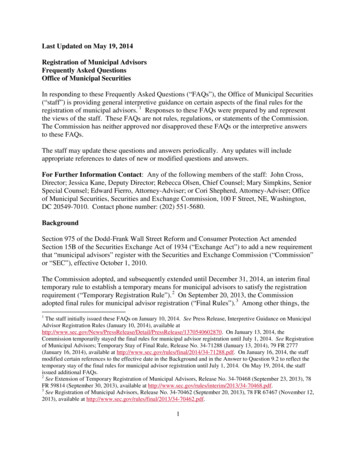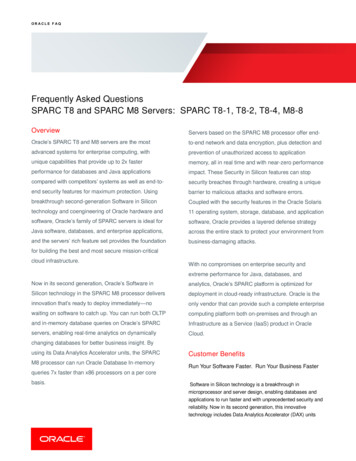
Transcription
ORACLE FAQFrequently Asked QuestionsSPARC T8 and SPARC M8 Servers: SPARC T8-1, T8-2, T8-4, M8-8OverviewServers based on the SPARC M8 processor offer end-Oracle’s SPARC T8 and M8 servers are the mostto-end network and data encryption, plus detection andadvanced systems for enterprise computing, withprevention of unauthorized access to applicationunique capabilities that provide up to 2x fastermemory, all in real time and with near-zero performanceperformance for databases and Java applicationsimpact. These Security in Silicon features can stopcompared with competitors’ systems as well as end-to-security breaches through hardware, creating a uniqueend security features for maximum protection. Usingbarrier to malicious attacks and software errors.breakthrough second-generation Software in SiliconCoupled with the security features in the Oracle Solaristechnology and coengineering of Oracle hardware and11 operating system, storage, database, and applicationsoftware, Oracle’s family of SPARC servers is ideal forsoftware, Oracle provides a layered defense strategyJava software, databases, and enterprise applications,across the entire stack to protect your environment fromand the servers’ rich feature set provides the foundationbusiness-damaging attacks.for building the best and most secure mission-criticalcloud infrastructure.With no compromises on enterprise security andextreme performance for Java, databases, andNow in its second generation, Oracle’s Software inanalytics, Oracle’s SPARC platform is optimized forSilicon technology in the SPARC M8 processor deliversdeployment in cloud-ready infrastructure. Oracle is theinnovation that’s ready to deploy immediately—noonly vendor that can provide such a complete enterprisewaiting on software to catch up. You can run both OLTPcomputing platform both on-premises and through anand in-memory database queries on Oracle’s SPARCInfrastructure as a Service (IaaS) product in Oracleservers, enabling real-time analytics on dynamicallyCloud.changing databases for better business insight. Byusing its Data Analytics Accelerator units, the SPARCM8 processor can run Oracle Database In-memoryCustomer BenefitsRun Your Software Faster. Run Your Business Fasterqueries 7x faster than x86 processors on a per corebasis.Software in Silicon technology is a breakthrough inmicroprocessor and server design, enabling databases andapplications to run faster and with unprecedented security andreliability. Now in its second generation, this innovativetechnology includes Data Analytics Accelerator (DAX) units
ORACLE FAQdesigned directly into the SPARC M8 processor’s silicon toFrequently Asked Questionshandle SQL primitives, such as those used by OracleQ: What are servers based on the SPARC M8 processor?Database In-Memory in Oracle Database 12c. Through theA: Servers based on the SPARC M8 processor are theworld’s most powerful systems for business-criticalenterprise applications and virtualized cloud infrastructure.Utilizing second-generation Software in Silicon technologyin the SPARC M8 processor, the servers providebreakthrough efficiency and performance as well asunprecedented levels of security.use of open APIs, the DAX units can also be leveraged byJava applications operating on streams of data. The DAX unitsoperate on data at full memory speeds, taking advantage ofthe very high memory bandwidth of the processor. Thisproduces extreme acceleration of in-memory queries andanalytics operations while freeing processor cores to do otheruseful work. In addition, the ability of the DAX units to handlecompressed data on the fly means that larger databases canbe kept in memory or that less server memory needs to beconfigured for a given database size. Lastly, the SPARC M8processor introduces Oracle Numbers units, which greatlyQ: How many products comprise the family of servers basedon the SPARC M8 processor?A: There are four servers in the product family, which havefrom one to eight processors.SPARC T8-1: The SPARC T8-1 server offers a singleprocessor with 32 cores in a 2U chassis. It scales up to 1TB of memory, offers up to eight 2.5-inch hot-serviceableSAS HDDs or solid-state drives (SSDs), supports up tofour NVMe SSDs, and has six PCIe 3.0 slots.accelerate Oracle Database operations involving floating pointdata. Consider the result: you can run fast in-memory analyticson your database, using much less memory than the size ofyour data, without significantly increasing server utilizationrates or affecting your OLTP operations.SPARC T8-2: The SPARC T8-2 server offers twoprocessors with a total of 64 cores in a 3U chassis. Itscales up to 2 TB of memory, supports up to six 2.5-inchhot- serviceable SAS HDDs or SSDs, supports up to fourNVMe SSDs, and has eight PCIe 3.0 slots.Secure Your Applications with No Trade-OffsThe Silicon Secured Memory feature of the SPARC M8processor provides the capability of detecting and preventinginvalid operations on application data, through hardwareSPARC T8-4: The SPARC T8-4 server offers two or fourprocessors with up to 128 cores in a 6U chassis. It scalesup to 4 TB of memory, supports up to eight 2.5-inch hotserviceable SAS HDDs, SAS SSDs, or NVMe SSDs, andhas 16 PCIe 3.0 slots utilizing hot-pluggable carriers.monitoring of software access to memory. This can stopmalware from exploiting software vulnerabilities, such as bufferoverflows. The hardware approach of Silicon Secured Memoryis much faster than traditional software-based detection tools,so security checks can be done in production withoutSPARC M8-8: The SPARC M8-8 server offers up to eightprocessors in a single physical domain. The server scalesup to 8 TB of memory and has up to 24 PCIe 3.0 (x16)slots.significant impact to performance. In addition, each processorcore contains the fastest cryptographic acceleration in theindustry, allowing IT organizations to deliver end-to-end dataencryption and secure transactions with near-zeroperformance impact. In summary, you can easily activate dataprotection and encryption security, by default, withoutadditional hardware investment.Q: What are the common characteristics of servers based onSPARC M8 processors?A: The servers contain the following common characteristics: Second-generation Software in Silicon featuresEngineered for the Cloud Fast DDR4 memory that lowers power consumptionOracle’s SPARC systems are engineered for the cloud and Dual inline memory module (DIMM) sparing that is enabledwith fully populated memory slots, increasing systemreliability and uptime x16-capable PCIe 3.0 slots, which provide more I/Othroughputprovide customers with effortless security, breakthroughefficiency, and straightforward simplicity. Oracle is the onlyvendor that can provide such a complete enterprise computingplatform both on-premises environments and IaaSenvironments in Oracle Cloud.1 FREQUENTLY ASKED QUESTIONS SPARC T8 AND SPARC M8 SERVERS
ORACLE FAQQ: What is Software in Silicon?A: Software in Silicon is a technology that places softwarefunctions directly into the processor chip, implemented asspecialized units or off-load engines. Because specificfunctions are performed in hardware, software applicationsrun much faster. And because the cores of the processorare freed to perform other functions, overall operations arespeeded up as well.Q: What are the key features of the SPARC M8 processor?A: One of the key features of the SPARC M8 processor isSQL in Silicon, which includes two subfunctions, InMemory Query Acceleration and In-Line Decompression,both of which are performed by the DAX units: Data Analytics Accelerator (DAX) units are additional onchip accelerator engines that offload both In-MemoryQuery Acceleration and In-Line Decompression from theprocessor cores. There are eight DAX units per SPARC M8processor, each with four pipelines. That means 32 insilicon accelerator engines are available to all 32 processorcores. Each engine accelerates analytics primitives suchas “search”, “join” and “filter”.In-Memory Query Acceleration increases theperformance of in-memory database queries by operatingon data that is streamed directly from memory viaextremely high-bandwidth interfaces. This technology canalso be used by Java Streams applications, through anopen API in the Oracle Solaris operating system.In-Line Decompression significantly increases usablememory capacity. The SPARC M8 processor runs datadecompression concurrently with the accelerated analyticsfunctions. This capability allows compressed databases tobe stored in memory while being accessed andmanipulated at full speed.Another key technology of the SPARC M8 processor isSecurity in Silicon, which includes two subfeatures: SiliconSecured Memory and Cryptographic Acceleration. Silicon Secured Memory ensures that an application isonly able to access its own memory region, which letssoftware programmers identify issues related to memoryallocation. It is designed to help prevent security hackssuch as Heartbleed from putting systems at risk, and itenables hardware monitoring of memory requests bysoftware processes in real time. It stops unauthorizedaccess to memory whether that access is due to aprogramming error or a malicious attempt to exploit bufferoverruns. It also helps accelerate code development andhelps ensure software quality, reliability, and security.Cryptographic Acceleration enables wire-speedencryption capabilities for secure data center operation2 FREQUENTLY ASKED QUESTIONS SPARC T8 AND SPARC M8 SERVERSwithout a performance penalty. This is provided by theprocessor’s 32 on-chip cryptographic accelerator units thatcan be accessed seamlessly through the Oracle SolarisCryptographic Framework. These units accelerate thewidest set of cyphers and hashes in the industry: Oraclehas demonstrated that wide key encryption can beperformed by the SPARC M8 processor with speeds thatare 7x faster on a per core basis compared to the latestx86 processors.Q: What types of applications are ideal for the servers basedon the SPARC M8 processor?A: The servers are ideal platforms for database, Java,middleware, and application workloads.Q: Can I run in-memory applications on the servers based onthe SPARC M8 processor?A: Absolutely. The outstanding performance of the innovativeSPARC M8 processor coupled with a large memoryfootprint allows many applications to run in memory onthese servers. Running Oracle In-Memory Applications onthe servers provides significant application performanceboosts.Q: Is Oracle Software in Silicon technology open?A: Yes, software developers can leverage Silicon SecuredMemory, the cryptographic instruction accelerators, and theDAX units. Oracle has released open APIs for both SiliconSecured Memory and the DAX units. In addition, thecryptographic accelerators are enabled via industrystandard APIs such as PKS#11, OpenSSL, and others, andby using the Oracle Solaris Cryptographic Framework.Learn more here.Q: Is there a choice in system configurations?A: Yes, servers based on the SPARC M8 processor can becustomized through the Oracle assemble-to-order process.Q: What operating systems are supported on the servers?A: Oracle Solaris 11.3 SRU 24 or later is supported in acontrol domain on the SPARC T8-1, T8-2, T8-4, and M8-8servers.In the guest domains, Oracle Solaris 11.3 SRU 24 or lateris supported and so is Oracle Solaris 10 1/13 (with requiredpatches).Applications certified for Oracle Solaris 9 or 8 only may berun in an Oracle Solaris 9 or 8 branded zone running withinan Oracle Solaris 10 guest domain
ORACLE FAQQ: What is the recommended operating system for theservers?Q: Can SPARC servers be managed with Oracle EnterpriseManager Ops Center 12c?A: Oracle recommends the latest version of Oracle Solaris 11for enhanced performance and functionality.A: The latest available version of Oracle Solaris 11, whichincludes Oracle VM Server for SPARC, is preinstalled.A: Yes. Oracle Enterprise Manager Ops Center 12c is an endto-end management solution that can monitor and manageall aspects of hardware and virtualization configurations onthe servers. It provides a complete cloud lifecyclemanagement solution including self-service provisioningand integrated chargeback and capacity planning.Q: What virtualization technologies are supported on theservers?Q: What are the power and cooling requirements for theservers?A: With the use of Oracle VM Server for SPARC, multipleapplication stacks can be deployed on both Oracle Solaris11 and Oracle Solaris 10, and they are fully supported sideby side. Additionally, individual Oracle Solaris 11 andOracle Solaris 10 instances can be virtualized with OracleSolaris Zones for optimal utilization and applicationperformance.A: The online power calculator provides guidance forestimating the electrical and heat loads for typicaloperating conditions.Q: What software is preinstalled on the servers?Even applications running on Oracle Solaris 9 and OracleSolaris 8 can be virtualized on legacy Oracle SolarisContainers. Physical domains provide an additional level ofpartitioning on SPARC M8-8 servers, which featureelectrical isolation.Q: What are the systems management options on theservers?A: Servers based on the SPARC M8 processor include OracleIntegrated Lights Out Manager (Oracle ILOM), which isdriven by an integrated system service processor that alsohas power-management and power-capping capabilities tohelp reduce energy costs.Oracle ILOM provides full remote keyboard, video, mouse,and storage (KVMS) support together with remote mediafunctionality.Oracle ILOM works with Oracle Enterprise Manager OpsCenter, which provides the most-comprehensivemanagement across Oracle servers, operating systems,and Oracle Solaris virtualization technologies, and itdramatically improves the efficiency of IT operations withits integrated lifecycle management and built-inautomation.In addition to Oracle ILOM, unified server virtualizationmanagement is achieved with Oracle VM Manager. OracleVM Manager can be used to discover SPARC serversrunning Oracle VM Server for SPARC and perform virtualmachine management tasks. Users can create SPARCserver pools and virtual machines, as well as managenetworking and storage.3 FREQUENTLY ASKED QUESTIONS SPARC T8 AND SPARC M8 SERVERSQ: Where can I obtain information about performancebenchmarks?A: Oracle’s SPARC system benchmarks are available here.Q: Where can I find official end-user documentation for thefamily of servers based on the SPARC M8 processor?A: Product documentation can be found at docs.oracle.com.Q: What is the hardware warranty on these servers?A: The servers come with a one-year warranty. Visitoracle.com/us/support/policies for more information aboutOracle’s hardware warranty.As with all product warranties, this warranty is designed tooffer consumers basic recourse should a product defect bediscovered. For more complete support, purchase therecommended support coverage at point-of-purchase togain access to the services and resources you need andavoid potential reinstatement fees at a later date.Q: What is the recommended support for the servers basedon Oracle's SPARC M8 processor?A: For all SPARC server products being used in criticalproduction and test environments, Oracle recommendsOracle Premier Support for Systems. Features include: Award-winning, 24/7 service and support to help you keepyour Oracle systems running at peak performance Comprehensive systems coverage that includes singlepoint accountability for Oracle server and storagehardware; integrated software (for example, firmware); andoperating system software (Oracle Solaris, Oracle Linux,and Oracle VM) Fast answers and prompt resolution with around-the- clockaccess to Oracle product experts, hardware service, andself-help technical resources
ORACLE FAQ Tools and resources to proactively mitigate risk, simplifyday-to-day IT operations, and maximize systemperformance including Oracle Enterprise Manager OpsCenter softwareQ: Where can I obtain additional information?Access to Oracle operating system patches, securityupdates, enhancements, and upgrades without additionallicense or support feesA: Contact your Oracle sales representative directly or call 1800- Oracle1. Additional information about Oracle’sSPARC servers is available on oracle.com.For more information, visit the Oracle Premier Support forSystems on oracle.com.1For Java and database workloads, at product release time.See the performance blogOracle Corporation, World HeadquartersWorldwide Inquiries500 Oracle ParkwayPhone: 1.650.506.7000Redwood Shores, CA 94065, USAFax: 1.650.506.7200CONNECT W ITH .com/oracleoracle.comCopyright 2017, Oracle and/or its affiliates. All rights reserved. This document is provided for information purposes only, and thecontents hereof are subject to change without notice. This document is not warranted to be error-free, nor subject to any otherwarranties or conditions, whether expressed orally or implied in law, including implied warranties and conditions of merchantability orfitness for a particular purpose. We specifically disclaim any liability with respect to this document, and no contractual obligations areformed either directly or indirectly by this document. This document may not be reproduced or transmitted in any form or by anymeans, electronic or mechanical, for any purpose, without our prior written permission.Oracle and Java are registered trademarks of Oracle and/or its affiliates. Other names may be trademarks of their respective owners.Intel and Intel Xeon are trademarks or registered trademarks of Intel Corporation. All SPARC trademarks are used under license andare trademarks or registered trademarks of SPARC International, Inc. AMD, Opteron, the AMD logo, and the AMD Opteron logo aretrademarksor registered trademarks of Advanced Micro Devices. UNIX is a registered trademark of The Open Group. 10204 FREQUENTLY ASKED QUESTIONS SPARC T8 AND SPARCM8 SERVERS
SPARC T8-4: The SPARC T8-4 server offers two or four processors with up to 128 cores in a 6U chassis. It scales up to 4 TB of memory, supports up to eight 2.5-inch hot-serviceable SAS HDDs, SAS SSDs, or NVMe SSDs, and has 16 PCIe 3.0 slots utilizing hot pluggable carriers. SPARC M8-8: The SPARC M8-8 server offers up to eight
